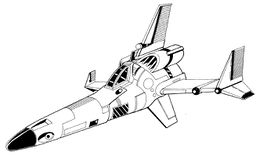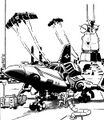Corsair (Aerospace Fighter class)
- This article is about the aerospace fighter design. For other uses, see Corsair.

| |
| Corsair | |
| Production information | |
| Manufacturer | Wangker Aerospace |
| Production Year | 2779[1] |
| Model | CSR-V12 |
| Class | Medium aerospace fighter |
| Tech Base | Inner Sphere |
| Cost | 2,293,958 C-bills |
| Technical specifications | |
| Mass | 50 tons |
| Structural Integrity | 6 |
| Frame | Wangker II |
| Power Plant | GM 200 |
| Armor | Wangker Corsair Standard |
| Fuel | 400 - 5 tons |
| Armament |
|
| Communications System | Ranker 100B |
| Tracking & Targeting System | Ranker TA800 |
| Heat Sinks | 16 single heat sinks |
| BV (1.0) | 1,006[2][3] |
| BV (2.0) | 1,190 |
Contents
Description[edit]
The Corsair was originally introduced as a means to replace the horrific losses suffered by the Star League Defense Force following the end of the Amaris Civil War. The compact laser systems and sleek design of the Corsair made it a superior aerospace fighter in an atmosphere, rivaling the capabilities of conventional fighters. It was well protected by 13.5 tons of armor, while 16 single heat sinks kept the all-energy weapon loadout from overheating. It carried a fuel load of five tons and its GM 200 power plant could achieve a maximum thrust of four and a half gravities, with a safe thrust factor of three gravities.[4][5]
A working prototype of the Corsair had already been produced when the SLDF approached Wangker Aerospace for an easy-to-refit aerospace fighter, which allowed them to begin full-scale production within months. Unfortunately the original V1 series had serious flaws: the fuel tank would rupture when the craft made turns operating in an atmosphere, the landing gear could not support its weight in an emergency landing, and the life support system in the cockpit was easily shattered. While such faults would have killed most other designs, the positive aspects of the Corsair were so impressive the Star League permitted its continuation while Wangker fixed the issues. The fuel tank problem would be corrected in the V2 series, while the life support issues were hashed out in the V3 through V8 series, with continuing improvements up to the V12 series[4][5]
Most of Wangker's Corsair factories were located in the Federated Suns, and so when the Star League fell five years after its introduction House Davion managed to seize control of them, with the Free Worlds League capturing a single production line on Connaught. Within five years of the start of the First Succession War however all of these factories had been destroyed, though through salvage efforts Wangker managed to piece together a new line on Axton and keep it open over the centuries of constant raiding. When the Connaught facility was destroyed in the opening shots of the war only a few hundred had been produced for the FWLM, and these eventually fell into the hands of the Principality of Regulus. When the Federated Commonwealth was formed debate raged on whether the Corsair or the Lucifer should be the AFFC's standard medium aerospace fighter, and in mock combat trials the Corsair won more often than not.[4][5]
Weapons and Equipment[edit]
Geared towards short range combat, the Corsair carries a total of two Martell medium lasers and four Exostar small lasers, while two Exostar large lasers gives it some additional reach. Both medium lasers are located in each wing, with the large lasers and two of the small lasers filling the nose. For coverage to the stern, the remaining two small lasers are mounted to the rear and tied directly into the targeting systems, giving the pilot extreme accuracy in his rear field of fire. The compact laser systems are also well-suited for a ground-attack role, while the presence of 16 single heat sinks means the Corsair can continuously fire both large lasers and fire the medium and small lasers with negligible heat buildup.[4][5]
Variants[edit]
- CSR-V12b
- Almost identical to the V14 variant, this version used during Operation Klondike removes the standard weaponry and replaces it with two nose-mounted ER large lasers, a nose-mounted medium laser, and a medium pulse laser in each wing. It also mounts 15 double heat sinks. BV (2.0) = 1,388[6][7]
- CSR-V12M (aka Sand Hawk)
- A House Marik design, it was introduced among the Regulan aerospace forces in an attempt to preserve their dwindling number of Corsairs. One of the large lasers was replaced with two more tons of armor and three additional single heat sinks. While increasing the craft's survivability, it is disliked by many for reducing the overall firepower. This variant is also known as the Sand Hawk to House Kurita military units.[4][5] BV (1.0) = 1,039[8][9], BV (2.0) = 1,121
- CSR-V14
- The V14 was introduced during the early 3050s, which consisted of a simple refit of the standard Corsair, exchanging the craft's large lasers for ER large lasers. Also as a part of the redesign, its single heat sinks were upgraded to double capacity. The upgrade came in the form of a refit kit for House Davion Corsairs and had completely replaced all vintage Corsairs by the start of the FedCom Civil War.[5] BV (1.0) = 1,259[10], BV (2.0) = 1,330
- CSR-V18
- An upgrade of the V14 design, this variant was introduced during the early portion of the Jihad. In addition to the fighter's ER large lasers, the craft's forward small lasers were removed and it was given a pair of light PPCs. The rear facing ones were upgraded to ER small lasers while 17 double heat sinks keep it cool. Finally the power plant was exchanged for an XL engine and its armor upgraded to heavy ferro-aluminum. Though the outbreak of the Jihad disrupted the distribution of these modern Cosairs, they have since made their way to many AFFS units and have received good reviews.[5] BV (1.0) = 1,127[11], BV (2.0) = 1,127
- CSR-V20
- This variant was introduced by House Davion during the Succession Wars. It replaces the medium lasers and small lasers with an SRM-6 system and ammo. V20s were typically seen in the Davions' Forty-second Avalon Hussars regiment. BV (1.0) = 986[12][13], BV (2.0) = 1,112
- CSR-X12
- Developed under the auspices of the RIGID NIGHT project by Paul Snell during the Jihad, this Corsair variant uses an experimental XXL engine to provide approximately 50% more speed than the standard CSR-V12. The existing weapons systems are replaced with Clan produced pulse lasers: two small pulse lasers cover the rear, while another pair of small pulse lasers and four medium pulse lasers fire forward. The weight savings from the XXL engine allowed engineers to add an extra five tons of standard armor. BV (2.0) = 2,000[14]
- CSR-12D
- This production version of the Corsair RIGID NIGHT prototype removes the Clan-spec lasers and the XXL engine. Instead, a standard XL engine provides power to the Corsair while the weapons consist of a large X-Pulse laser and medium X-Pulse laser in the nose, an ER medium laser in each wing, and another medium X-Pulse laser covering the rear. The slightly smaller engine provides nearly 90% of the XXL engine of the RIGID NIGHT, a loss of speed that was thought acceptable. Finally the entire airframe is covered in 14.5 tons of heavy ferro-aluminum armor, which provides enough protection for most dogfights. The variant use a Rander 200B communications system. BV (2.0) = 1,619[15][16]
Custom Variants[edit]
- Corsair Bob
- Flown by a pilot in the Tsamma Crucis March Militia, this variant of the Corsair replaces the standard CSR-V12's weaponry with a RAC/5 and Streak SRM-6. Engine and speed performance remain the same as the CSR-V12, but an additional half-ton of armor is on the airframe. Three tons of autocannon ammo keep the Corsair Bob in the fight and the ammo efficient Streak launcher gets one ton of ammunition. BV (1.0) = 1,216[17]
Design Quirks[edit]
The CSR-12D Corsair variant is subject to the following Design Quirks:[15]
Notes[edit]
- Author Blaine Lee Pardoe stated in a blog entry that, according to his memory which he admitted could be wrong, the Corsair was among the aerospace fighters for which he invented the name and wrote the original background as initially published in TRO:3025, after being given only its art and game stats to work with for the TRO entry.
- TRO 3039 and RS: 3039 battle values differ. As of this writing have not been corrected in PDF form.
- In German products, the unit's proper name was translated to Korsar. The model code was accordingly changed to KSR-V12. The variant V12M aka Sand Hawk was perfectly translated to Wüstenfalke.
Gallery[edit]
Original CSR-V12 Corsair from TRO:3025
CSR-V12 Corsair from TRO:3025 Revised
Variant CSR-12D Corsair from TRO:Proto
A Corsair being refueled, from FM:ComStar
References[edit]
- ↑ MUL online date for the Corsair (Aerospace Fighter class)
- ↑ Record Sheets: 3039, p. 252
- ↑ AeroTech 2 Record Sheets, p. 78
- ↑ 4.0 4.1 4.2 4.3 4.4 Technical Readout: 3025 Revised, p. 156
- ↑ 5.0 5.1 5.2 5.3 5.4 5.5 5.6 Technical Readout: 3039, p. 200
- ↑ Record Sheets: Operation Klondike, p. 85
- ↑ Historical: Operation Klondike, p.160
- ↑ Record Sheets: 3039, p. 253
- ↑ AeroTech 2 Record Sheets, p. 80
- ↑ Record Sheets: 3039, p. 254
- ↑ Record Sheets: 3039, p. 255
- ↑ Record Sheets: 3039, p. 256
- ↑ AeroTech 2 Record Sheets, p. 79
- ↑ Experimental Technical Readout: Davion, p. 12
- ↑ 15.0 15.1 Technical Readout: Prototypes, p. 173
- ↑ Record Sheets: Prototypes, p. 87
- ↑ Record Sheets: Unique Fighters, p. 8
Bibliography[edit]
- AeroTech 2 Record Sheets
- Experimental Technical Readout: Davion
- Master Unit List: Battle Values
- Record Sheets: 3039
- Record Sheets: Operation Klondike
- Record Sheets: Prototypes
- Record Sheets: Unique Fighters
- Technical Readout: 3025
- Technical Readout: 3025 Revised
- Technical Readout: 3039
- Technical Readout: 3057
- Technical Readout: Prototypes






